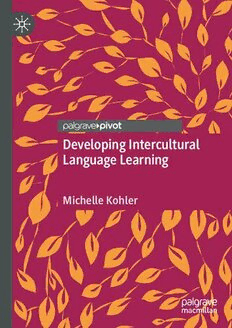
Developing Intercultural Language Learning PDF
Preview Developing Intercultural Language Learning
Developing Intercultural Language Learning Michelle Kohler Developing Intercultural Language Learning “Drawing thoughtfully on an elaborated understanding of languages learning within an intercultural orientation and a commitment to praxis, in this book MichelleKohleraddressesthecompellingquestionofhowtoengenderthedevel- opment of learners as language learners, language users and as persons capable ofinterpreting,creatingandexchangingmeaningsacrosslanguagesandcultures. With her voice both as researcher and teacher she considers, in a fundamental andauthenticway,theroleofteachersinpromotingsuchlearning.Throughher accountofasustainedself-study,shetracesinsightfullytheprocessesofplanning and designing, enacting and mediating, and assessing and evidencing students’ languagelearning,foregroundingconcepts,experiencesandreflectiveprocessesin designinglearning,andstudents’interpretations,reactionsandreflections,intime andovertime,inresponse.Sheexplainsandillustratesamplyherowntheorising andpracticeinawaythatexemplifiestheintellectuallyrichandethical,ecological stance towards languages learning and development that she is advocating.” —Angela Scarino, Associate Professor in Applied Linguistics and Director of the Research Centre for Languages and Cultures, University of South Australia Michelle Kohler Developing Intercultural Language Learning Michelle Kohler UniSA Justice and Society University of South Australia ADELAIDE, South Australia, Australia ISBN 978-3-030-59112-0 ISBN 978-3-030-59113-7 (eBook) https://doi.org/10.1007/978-3-030-59113-7 © The Editor(s) (if applicable) and The Author(s), under exclusive licence to Springer Nature Switzerland AG 2020 This work is subject to copyright. All rights are solely and exclusively licensed by the Publisher, whether the whole or part of the material is concerned, specifically the rights of translation, reprinting, reuse of illustrations, recitation, broadcasting, reproduction on microfilms or in any other physical way, and transmission or information storage and retrieval,electronicadaptation,computersoftware,orbysimilarordissimilarmethodology now known or hereafter developed. The use of general descriptive names, registered names, trademarks, service marks, etc. in this publication does not imply, even in the absence of a specific statement, that such namesareexemptfromtherelevantprotectivelawsandregulationsandthereforefreefor general use. Thepublisher,theauthorsandtheeditorsaresafetoassumethattheadviceandinforma- tion in this book are believed to be true and accurate at the date of publication. Neither the publisher nor the authors or the editors give a warranty, expressed or implied, with respecttothematerialcontainedhereinorforanyerrorsoromissionsthatmayhavebeen made.Thepublisherremainsneutralwithregardtojurisdictionalclaimsinpublishedmaps and institutional affiliations. Cover illustration: © Melisa Hasan This Palgrave Pivot imprint is published by the registered company Springer Nature Switzerland AG The registered company address is: Gewerbestrasse 11, 6330 Cham, Switzerland Figures created by Ari Bickley For my boys Contents 1 Introduction 1 Changing and Challenges Times in Education 2 Reconceptualising Language Teaching 3 What Is Intercultural Language Learning? 5 What Do We Know and Still Need to Know? 6 About This Book 8 References 9 2 Why a Developmental Perspective Matters for Intercultural Language Learning 13 A Paradigm Shift in Second Language Learning 14 Reframing the Goals of Language/s Education 17 An Intercultural and Multilingual Orientation 18 Curriculum Design 19 Pedagogical Stance 22 Understandings of Development 33 SLA and Second Language Development 33 The Bioecological Model of Human Development 35 Experiential Learning 37 DevelopmentWithinanInterculturalLanguageTeaching Orientation 40 Conclusion 45 References 46 vii viii CONTENTS 3 Designing Programs for Developing Intercultural Language Learning 53 The Educational Context 54 Design of the Case Study 55 Knowing the Learners 58 Why Knowing Learners Matters 58 Finding Out About Learners 59 Using Profiling Information to Inform Practice 60 Designing the Teaching and Learning Program 62 Aims, Goals and Objectives 63 Intermediate Indonesian 65 Scoping the Program 67 Sequencing the Program 77 Conclusion 86 References 87 4 Enacting and Mediating the Development of Intercultural Language Learning 89 Dimensions of Enactment 90 Pedagogical Stance 90 Mediating Through Instruction and Interactive Talk 92 Mediating Through Texts and Resources 94 Conclusion 98 References 99 5 Assessing and Evidencing the Development of Intercultural Language Learning 101 Issues and Considerations in Assessing Intercultural Language Learning 102 Designing Assessment for Intercultural Language Learning 104 Evidencing development of intercultural language learning 112 Example 1: Justin 112 Example 2: Emma 117 Example 3: Jim 122 Conclusion 129 References 129 CONTENTS ix 6 Insights and Conclusion 131 Insights About Developing Intercultural Language Learning 132 Implications for Developing Intercultural Language Learning 135 The Future 137 References 137 References 139 Index 149 List of Figures Fig. 3.1 Student profile questionnaire 61 Fig. 3.2 Considerations in designing programs for intercultural language learning 72 Fig. 3.3 Interrelated layers of programming over time 79 Fig. 5.1 The translating/mediating and think aloud assessment 107 Fig. 5.2 The excursion recount assessment 109 Fig. 5.3 The bilingual/intercultural resource and reflection assessment 111 Fig. 6.1 Characteristics for complexifying intercultural language learning 133 xi List of Tables Table 2.1 The set of strands and sub-strands of the Australian Curriculum: Languages 21 Table 3.1 The teaching and learning program—Intermediate Indonesian 68 Table 3.2 Overview of experiences and learning demands 83 xiii
